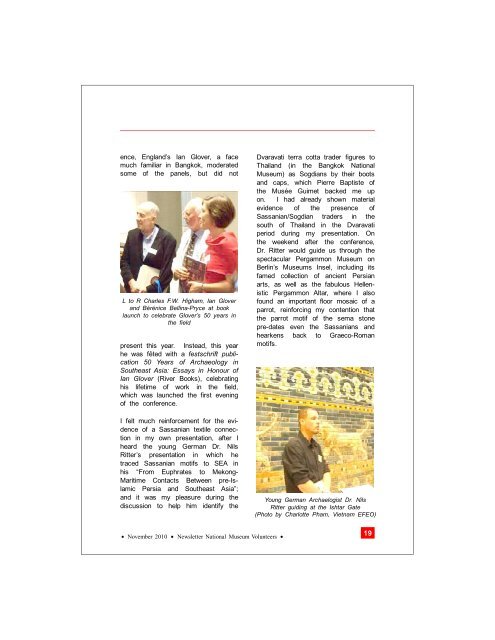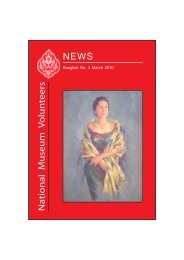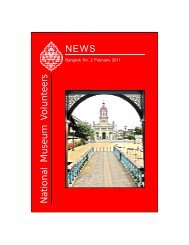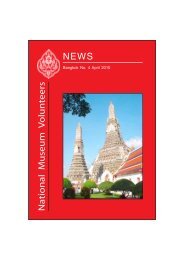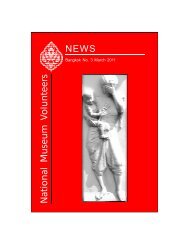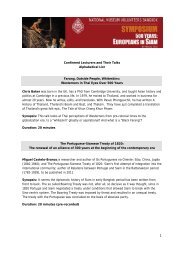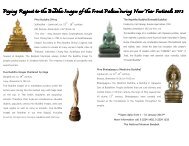November 2010 - National Museum Volunteers
November 2010 - National Museum Volunteers
November 2010 - National Museum Volunteers
You also want an ePaper? Increase the reach of your titles
YUMPU automatically turns print PDFs into web optimized ePapers that Google loves.
ence, England’s Ian Glover, a face<br />
much familiar in Bangkok, moderated<br />
some of the panels, but did not<br />
L to R Charles F.W. Higham, Ian Glover<br />
and Bérénice Bellina-Pryce at book<br />
launch to celebrate Glover’s 50 years in<br />
the field<br />
present this year. Instead, this year<br />
he was fêted with a festschrift publication<br />
50 Years of Archaeology in<br />
Southeast Asia: Essays in Honour of<br />
Ian Glover (River Books), celebrating<br />
his lifetime of work in the field,<br />
which was launched the first evening<br />
of the conference.<br />
I felt much reinforcement for the evidence<br />
of a Sassanian textile connection<br />
in my own presentation, after I<br />
heard the young German Dr. Nils<br />
Ritter’s presentation in which he<br />
traced Sassanian motifs to SEA in<br />
his “From Euphrates to Mekong-<br />
Maritime Contacts Between pre-Islamic<br />
Persia and Southeast Asia”;<br />
and it was my pleasure during the<br />
discussion to help him identify the<br />
Dvaravati terra cotta trader figures to<br />
Thailand (in the Bangkok <strong>National</strong><br />
<strong>Museum</strong>) as Sogdians by their boots<br />
and caps, which Pierre Baptiste of<br />
the Musée Guimet backed me up<br />
on. I had already shown material<br />
evidence of the presence of<br />
Sassanian/Sogdian traders in the<br />
south of Thailand in the Dvaravati<br />
period during my presentation. On<br />
the weekend after the conference,<br />
Dr. Ritter would guide us through the<br />
spectacular Pergammon <strong>Museum</strong> on<br />
Berlin’s <strong>Museum</strong>s Insel, including its<br />
famed collection of ancient Persian<br />
arts, as well as the fabulous Hellenistic<br />
Pergammon Altar, where I also<br />
found an important floor mosaic of a<br />
parrot, reinforcing my contention that<br />
the parrot motif of the sema stone<br />
pre-dates even the Sassanians and<br />
hearkens back to Graeco-Roman<br />
motifs.<br />
Young German Archaelogist Dr. Nils<br />
Ritter guiding at the Ishtar Gate<br />
(Photo by Charlotte Pham, Vietnam EFEO)<br />
. <strong>November</strong> <strong>2010</strong> . Newsletter <strong>National</strong> <strong>Museum</strong> <strong>Volunteers</strong> . 19


